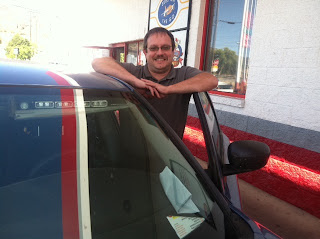Before I left on this trip, I bought a big, thick, Sharpie and a large piece of foam board, which I cut into smaller rectangles to make signs. I came to believe those with specific locations worked best. But the question remained: How close and how significant should the location on the sign be?
Here's how I used them:
 West.
West. I started with this one, in Minnesota. (It's in the early blog post with the picture of me getting on the commuter train out of town. See "Departing in 2 minutes" post. ) It got me a couple of short rides the first day (see "Day 1 adventures" post). After holding it for two fruitless hours at the on-ramp at Albany, Minn., the second day, I sat down and made
NoDak. John Berger, the rodeo guy hauling bucking bulls who picked me up and took me all the way to Mandan (see "Clean Cut Fellows" post), said he was impressed I knew the local term for "North Dakota."
At Mandan, I distinctly remember making a sign that read Glendive on one side, which I hoped would get me into Montana that night, and Billings on the other, which would get me further down the line -- to where the mountains first appear. But I must have left that in the car with Dan (see "Montana fishing" post), who drove me all the way to Bozeman. There, under tree outside a convenience store, I made the sign for

Missoula. And if I got that far, well, I might as well write Spokane on the back. I got to Three Forks, Mont., that night, and the next morning Dan the Beer Man took me straightaway (well, with a little weaving at 90 mph; See "Saved" post) right to Missoula, where he was going. He said the sign is one reason he turned around after passing me (the other being the voice of God). There I held the Spokane sign for two hours at a westbound on-ramp at the center of town, before wandering off under a tree for a short break. I guessed eight of 10 cars getting on the freeway there had had Idaho plates, so that's when I shortened my swing and made a different sign reading
Idaho. Maybe the Idahoans didn't know Spokane is just beyond their state line. Maybe they thought I was a shameless social leech, or that sharing one's car space was an attack on rugged individualism, or was otherwise anti-Idaho. Who knows? Maybe the sign should have read "Famous Potatoes." Anyway, after three hours total I finally got the ride all the way through the Idaho panhandle to Spokane. (So there, Idaho! See "Saved!" post.) That's where I got off the interstate and began the final leg, 166 miles on two-lane roads through what I'd heard would be a desolate stretch of eastern Washington, though towns that were just dots on the map, to my ultimate destination, Twisp. The back of the Idaho sign was blank. But what to write on it? Where would people be going? Figuring people might be hauling boats to Roosevelt Lake at Grand Coulee Dam or taking the kids to see an engineering marvel, I wrote:
Coulee Dam. It was a couple of hours before Dan Redfield (see "Police Escort No. 1" post) picked me up just outside Spokane and took me 80 miles right to Coulee Dam (the town). He'd seen my sign traveling the opposite direction into Spokane for a meeting, and damn if I wasn't still heading to the same place when he returned. In Coulee Dam, I checked the map and composed a double-decker sign with the names of the two towns 47 miles further where there would be junctions I needed:
Brewster
Pateros. Of the trickle of traffic up the hill on Hwy. 174 out of Coulee Dam, a remarkable number of cars turned off on the handful of side streets in the quiet town before they even got to me. Then Duane McClung, the tribal corrections officer, picked me up and drove me about 40 miles to Bridgeport and Chief Joseph Dam. (See "Police Escort No. 2" post.) I wasn't quite to Brewster/Pateros, so I walked through Bridgeport with that sign. In my pack, I still had my trump card, which I'd made back in Coulee Dam: a sign with one small (but big) word:
 Twisp.
Twisp. I never used it. Cloud pulled over in the Audi and, after I told him I was actually going beyond Pateros to Twisp, told me he was, too, and he'd take me all the way there. (See "The Best Came Last" and "Arriving in Style" posts.) I believe I left the Brewster/Pateros sign in his car, because I don't have it now, and the Twisp sign is on a small shelf in my pal Don's house, on the mountainside there.
P.S. : For the trip to Seattle and the airport, I was out of white foam board and used a small piece of brown corrugated cardboard reading, "Seattle." I'm afraid it had sort of a transient, "homeless/broke" look to it, but Seattle's the only place on Hwy. 20 anyone is going, so maybe it didn't matter. (See "Twelve hours from Twisp" post.) I either left it in Jim Hunter's car or tossed it in a trash can; it was different from the others, and I hadn't grown attached to it. In any case, next time: Much more artful signs.












